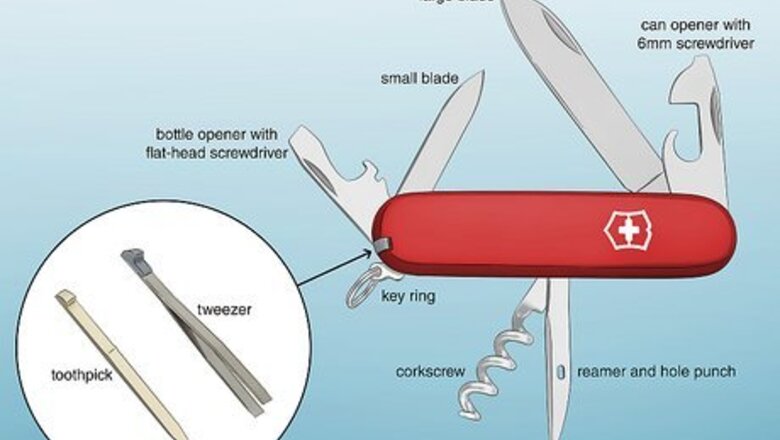
views
Using Basic Features

Learn how to use the main features. There is a wide variety of possible functions, but many of these are limited to expensive special-use knives. If you're using a simple, standard Swiss Army knife, then you'll probably only be working with 4-10 basic tools. Most Swiss Army knives include some combination of the following: Large blade and small blade Corkscrew Can opener with 3 mm flat-head screwdriver Bottle opener with 6 mm screwdriver, plus wire stripper and bender Reamer and hole punch Key ring Tweezers Toothpick

Use the large blade. This is the basic component of the Swiss Army knife. This blade is usually about as long and thick as the knife handle. Use it for almost anything that requires a knife. Be sure to exercise knife safety: always cut the knife away from your body, and be very careful not to let the blade snap shut with your fingers in the way. Cut your food, or gut a fish, or slice paper. Carve your initials into a tree or whittle a piece of wood into another shape. Cut anything that needs to be cut.
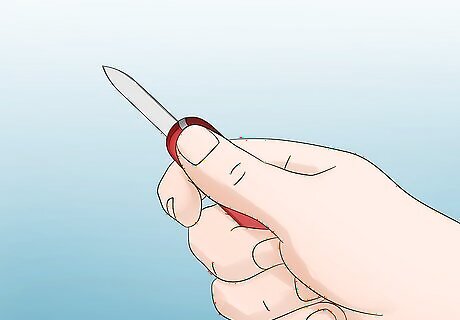
Unfold the small blade. Your knife may or may not include a small blade. It usually holds the same shape as the large blade, only slightly smaller. Use it in situations that call for a more delicate touch.
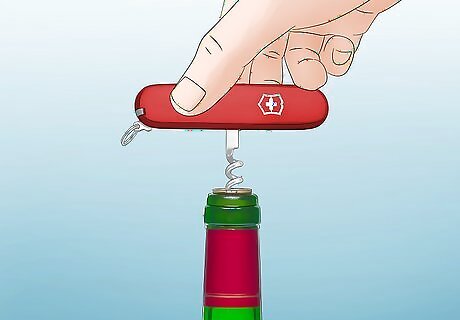
Use the corkscrew. Some Swiss Army knives include a metal corkscrew for opening wine bottles. Fold the corkscrew out so that it extends straight out from the knife – as though the knife body is the handle. Use the knife-handle to twist the corkscrew into the cork, and pull firmly on the handle to remove the cork from the bottle. Be sure to remove the mini screwdriver first, if your knife includes this feature. Not all Swiss Army knives come with a mini screwdriver.
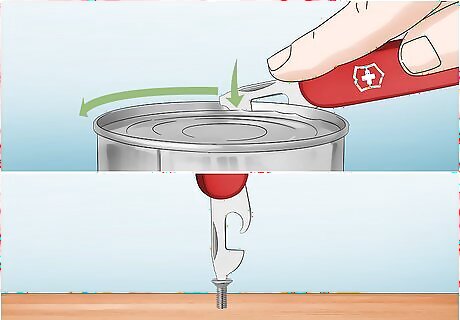
Open cans with the can opener. This is not your modern twist-cut can opener: it is an old-school manual can opener. Put the lip of the can into the cap of the can opener, then press the sharp bit into the lid of the can until it punctures through. The tip of the can opener also functions as a 3 mm flat-head screwdriver! You can also use the tip of the can opener on Phillips-head screws, if you angle it to use the point instead of the flat breadth.
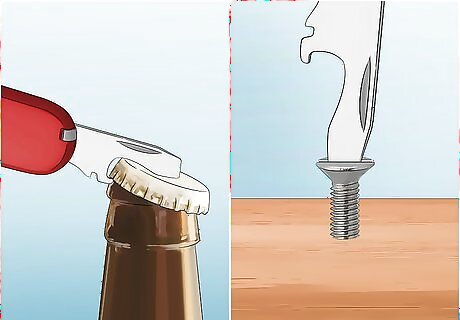
Identify the bottle opener. Use this to open bottles of your drink of choice. The flat tip of the bottle opener also functions as a 6 mm flat-head screwdriver. Use it when you need something larger than the 3 mm can opener screwdriver. Look for the wire stripper and bender. It is a small notch on the bottom of the bottle opener tool.

Find the reamer. This tool is also known as an awl. Use it for punching holes in materials like leather or canvas, and for drilling (or reaming) holes into sturdier materials like wood. The tool is intentionally tapered so that you can enlarge a hole by digging deeper and scraping the sides with the sharp edge.
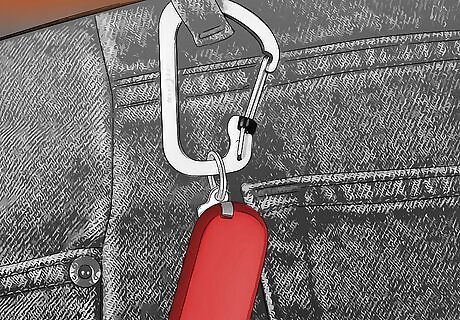
Use the key ring. Find this hanging from the outside of your knife. You can use this to clip the knife to your key-chain, your belt loop, or another handy location. You can also attach other useful tools or survival necessities to the Swiss Army knife to keep them in the same place.
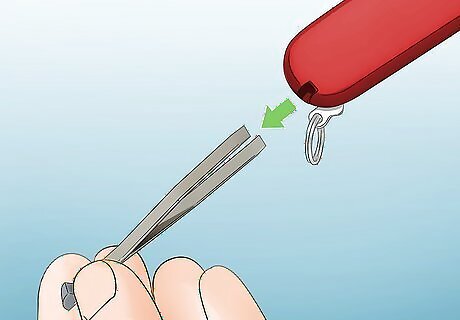
Pull the tweezers and toothpick from the end of the knife handle. The end of the tweezers usually looks like a small knob of grey plastic, while the end of the toothpick is a small knob of tan plastic. Make sure to wash the tweezers and toothpick after each use!
Caring for the Knife
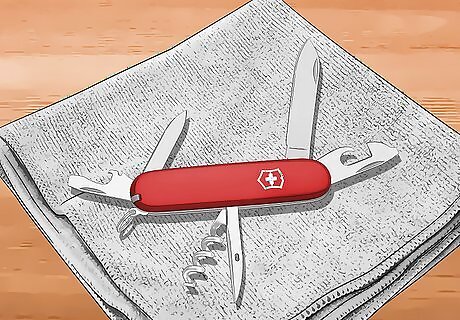
Keep the tools dry. Swiss Army Knives are made of stainless steel, which is much more water-resistant than regular steel. However, if you get them wet, it's still best to dry them relatively quickly. If you get your knife wet: dry off every tool and the base as fast as you can. Dry it by hand, and then let it sit out to dry more thoroughly. Let it sit open for 10-30 minutes.
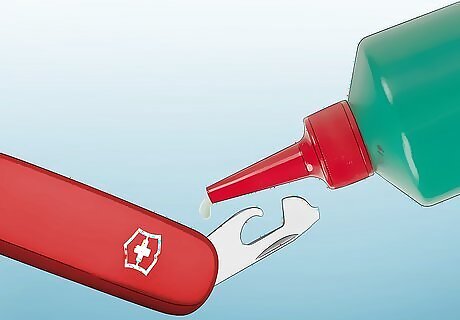
Oil the blade regularly. Place a dollop of lubricating multitool oil on the blade joint when the blade is starting to stiffen. Your manual will tell you how to oil and repair it.
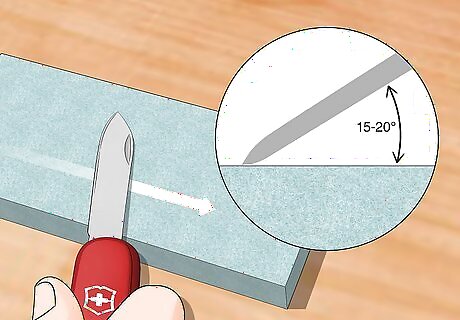
Sharpen the blades. The sharpening technique will differ slightly for straight blades and serrated blades. Use the "straight cut" method for the standard Swiss Army knife. Straight cut: Sharpen your blade using a whetstone at an angle of 15-20°. This will result in a cutting angle of 30-40°. If you are sharpening on a grinding wheel, make sure to cool the metal with plenty of water. This might help avoid high temperatures and damage to the blade. Serrated cut: Hone the blade with a sharpening stone. Pull it across the flat side of the serrated cut at an angle of 15-20°.
Identifying Complex Features
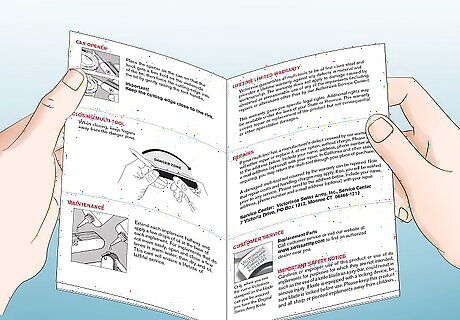
Identify which features you have. There are many models of Swiss Army knife, each with a unique set of included features. Each knife is designed for a certain type of user, from the casual urban bottle-opener to the serious survivalist. Knives fall into a few main categories: pocket knives, Swiss Army knives, and lock blade knives. Some models include: classic, tinker, super tinker, angler, camper, huntsman, handyman, mechanic boy, rescue tool, and Swiss champ. They come in categories like everyday, sports and leisure, DIY, LED lights, outdoor, executive, gardening, multitool lights, and scouting. Read the manual. If you've just bought your Swiss Army knife, be sure to read about the tools that come with your particular knife model. Read about the repairs, maintenance, and correct functions of the tool.
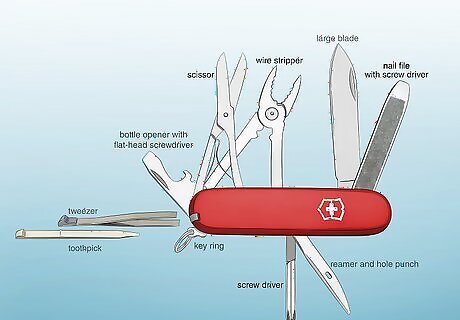
Use a small Victorinox pocket knife. These knives are usually smaller than the standard model, and they contain fewer features. A pocket knife may contain all or some of the following tools: Find the large blade, the nail file with a nail cleaner, the scissors, and the key ring. Pull tweezers and a plastic toothpick from the end of the knife handle. Find the nail file, the end of which is a flat-head screwdriver. Look for a bottle opener with attached nail file. Unfold the Phillips screwdriver, and look for the wire stripper. Some pocket knives even feature a bright LED, a ballpoint pen, and a USB drive.

Navigate a full-fledged Swiss Army knife. This is the knife type with the most potential features. Some Swiss Army knifes come with as few as four tools, while others are packed with up to 38 unique functions. The standard model may contain all or some of the following tools: Find the large blade and the small blade, the corkscrew, the key-ring, and the can opener. Pull tweezers and a toothpick from the end of the knife handle. Some knives include more delicate tools like a scissors, a magnifying glass, a sewing eye, a stainless steel pin, and a pressurized ballpoint pen. Check for a bottle opener with screwdriver and wire stripper. Look for the nail file with metal file and nail cleaner. Find the pliers, which usually include wire cutters and a wire crimping tool. Look for a paper reamer and hole punch. Look for the small flat-head screwdriver at the tip of the can opener. Check if your knife has a 2.5 mm screwdriver, a Phillips screwdriver, and/or a mini-screwdriver. Some models even feature a wood saw, a metal saw, a multi-purpose hook, or a fish scaler with ruler and hook disgorger. Find the chisel and scraper. Look for a wrench with a 5 mm or 4 mm hex drive.
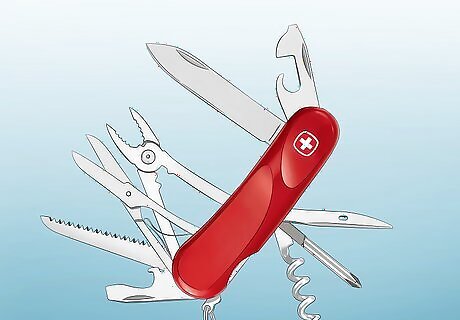
Unfold a lock blade knife. This tool is larger than the standard Swiss Army knife, and the handle is curved for better grip. Use the lock blade for more serious cutting: it locks into place such that you must disengage the safety to close it. A standard pocket knife will still fold back into the handle when you apply force to the dull side of the blade. A lock blade knife may include the following features: Open the large lock blade and feel how it sticks in place when fully unfolded. Look for a curved lock blade for one-hand opening, which features a 2/3 wavy cut. Find the wood saw, the metal saw (with metal file), and the scissors. Pull the tweezers and toothpick from the end of the handle. Find a 1-2 inch Phillips screwdriver, a long, small Phillips screwdriver, or a mini-screwdriver. Identify the corkscrew, the can opener (the end of which is a flat-head screwdriver), and the bottle opener (which also acts as a screwdriver and wire stripper.) Find the pliers, with wire cutters and wire crimping tool included. Look for the emergency features. Lock blade knives often include a window breaker, a seatbelt cutter, a nylon cord, and a saw for shatterproof glass.













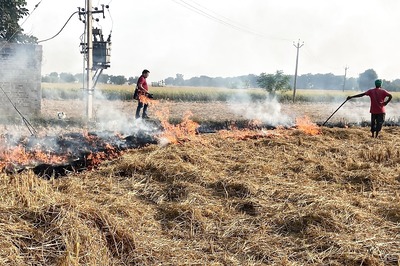





Comments
0 comment